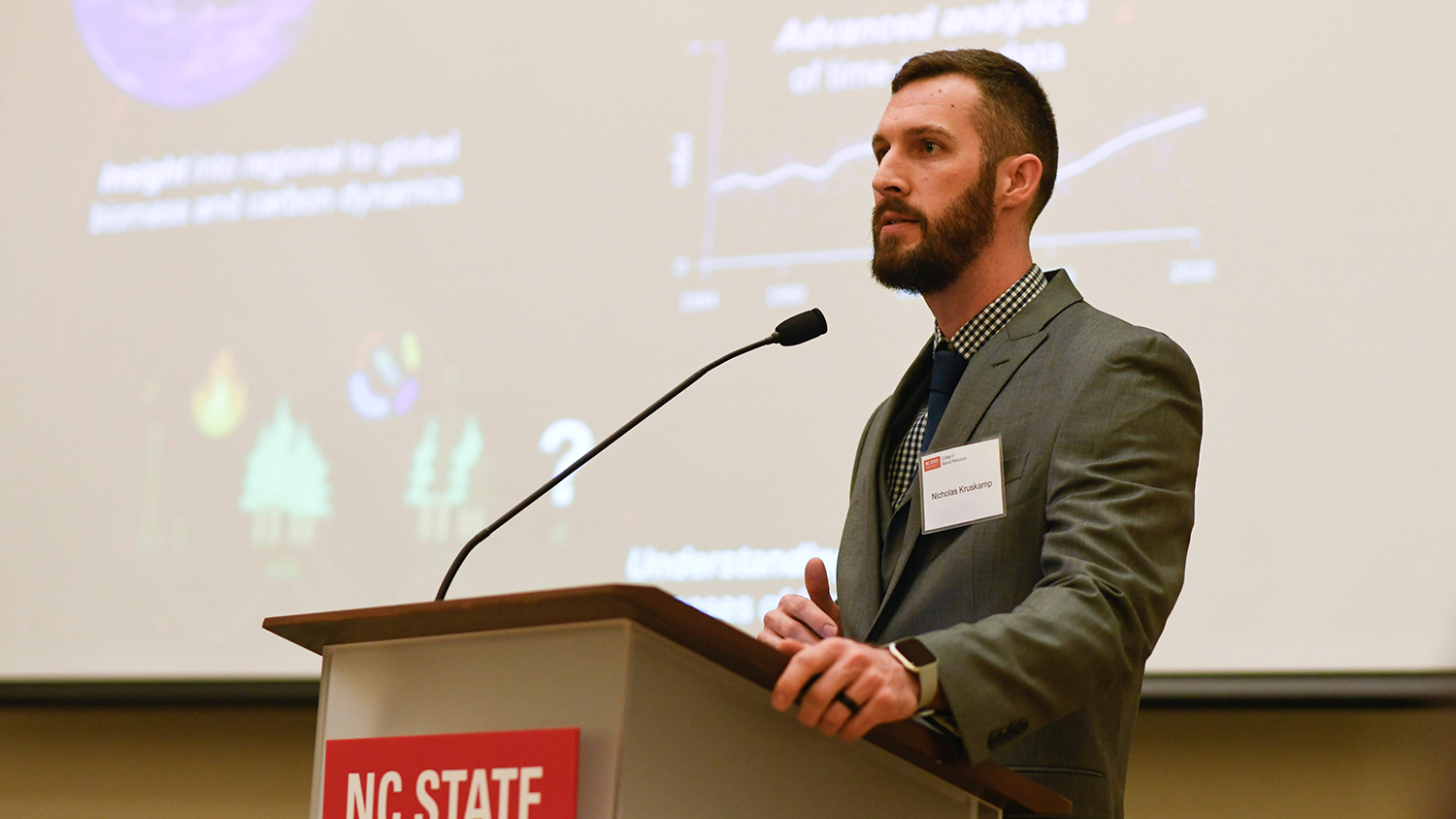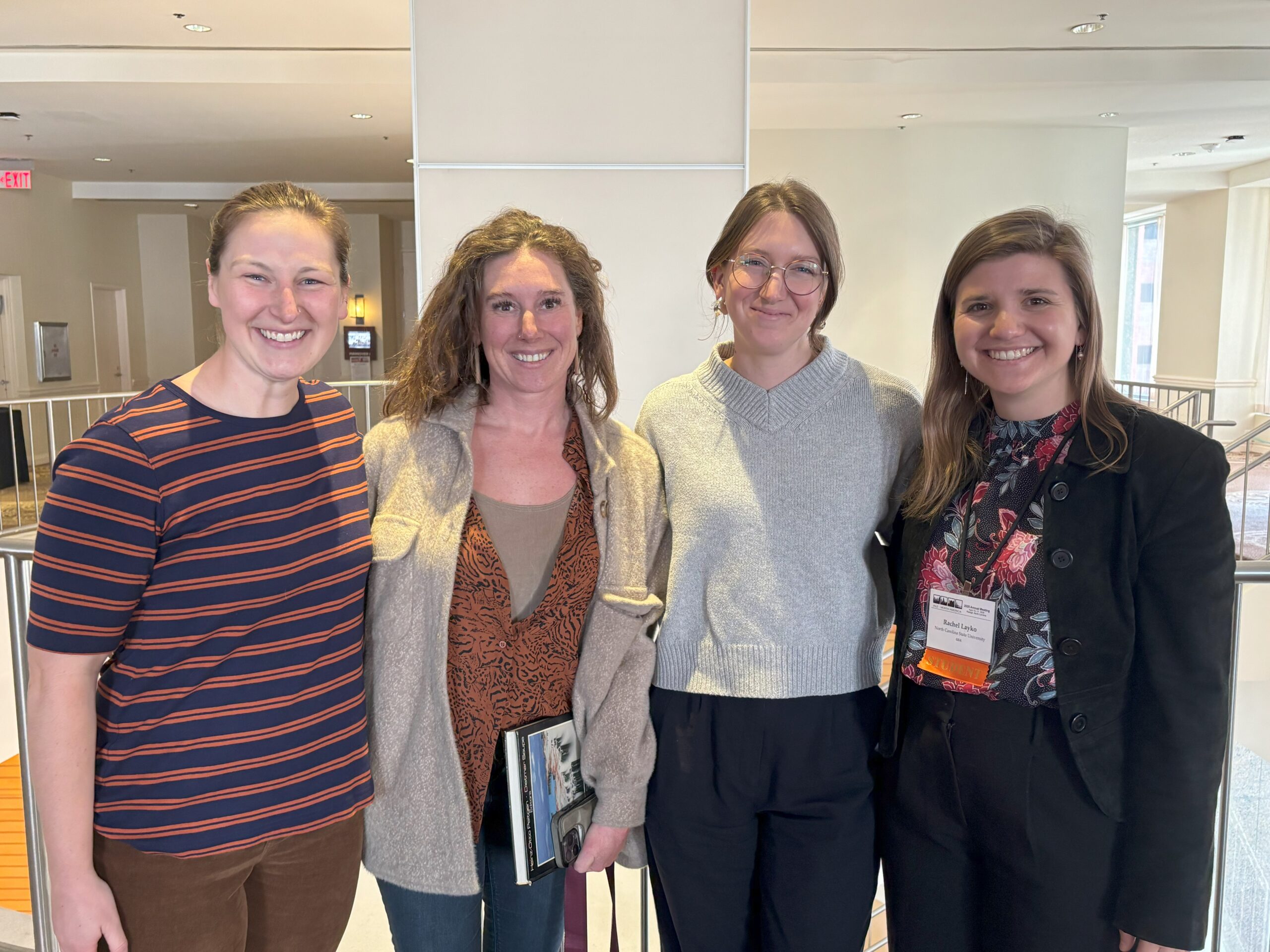Student Presentation Tips from a 3MT Champ

At February’s Graduate Research Symposium hosted by the College of Natural Resources, Geospatial Analytics doctoral candidate Nick Kruskamp took first place in the Three-Minute Thesis (3MT) competition, a challenge that pushes students to sum up their graduate research in just one presentation slide and a mere 180 seconds.
Only two months before, Kruskamp won an Outstanding Student Presentation Award (OSPA) at the American Geophysical Union (AGU) 2019 Fall Meeting for his talk entitled: “Web-based Decision Analytics For Mapping Host Species Distributions and Forecasting the Spread of Forest Pests and Pathogens.” OSPAs recognize students “for quality research in Earth and space science and the ability to effectively communicate it,” explains the AGU.
Clearly, Nick has a knack for effectively communicating his impactful work! We caught up with him to learn his tips for putting together a winning talk.
Congratulations on your presentation honors! What would you say is the most important piece of advice (or two!) you would give to other graduate students as they prepare a research talk?
In many ways, what I’ve been trying to do in my presentations is just apply the “and, but, therefore” and funnel techniques. This is so much easier said than done, and it has taken a lot of practice and failing to get things right. You start broadly with general concepts everyone can relate to using “and, but, therefore,” funnel down to the important details, and then broaden back out in your conclusion. Make sure to broaden back out and finish strong! The end of your presentation isn’t an afterthought––it’s the last thing you audience hears and sees and will leave a lasting impression on your audience. Leave time for this!
For example, in my Three-Minute Thesis presentation, my slide was literally a big circle diagram of arrows that started and ended with a picture of Earth from space (the Earth seems pretty broad right?!). The story I told the audience follows that circle diagram from Earth, down into the details of my research and back up. I could easily explode that diagram out into a 15+ minute presentation going into greater detail at each point, but the structure would remain the same.
What do you think is the most common mistake that presenters make in research talks?
Cramming so much into a presentation that you forget the “so what.” Your audience is likely to see dozens of presentations in a day. There is only so much information they are going to retain from a single presentation. So your job is to be as focused and tight in your presentation as possible. That can be hard to do, because when you are intimately involved with the work, every detail seems important.
At my AGU presentation, I focused on a couple major points I wanted the audience to walk away with. I worked backwards from there to tell a story that I thought the audience would care about. I re-stated my main points multiple times throughout the presentation. Any information that didn’t directly support those main points was cut. That was hard to do because I want everything to matter, but cutting out so much left a very focused and streamlined presentation.
What was the first professional research presentation you ever gave as an undergrad or as a grad student? Would you say your presentation style has changed since then?
I think I’ve blocked many of them from my memory! I still have slides from a presentation that I gave at an American Society for Photogrammetry and Remote Sensing annual meeting. It’s a shining example of what not to do! Every slide had multiple bullet points and sub-bullet points. Many slides had no pictures at all. I was obviously relying heavily on the slides to tell me what to say. There was no clear introduction––I just jumped directly into research questions and methods.
I do think my presentation style has changed, and much of that has come from practice, experimentation and learning from my mistakes. I’ve had more presentations flop than succeed. I’ve tried a lot of different things over the years to find what works best for me. But when I look back I see improvement over time. Additionally, I’ve tried to watch presentations more critically to identify as an audience member what I connect with and what falls flat. Then I try to emulate what works.
Have there been particular presentations or presenter styles that have inspired you?
There was a presentation at an American Geophysical Union fall meeting a few years ago that I still remember. On a technical level, I was completely lost! It was completely outside my expertise, but from the very beginning, the presenter walked the audience through in a way that anyone could understand. I walked away from that presentation absolutely sure this was a critical issue of the highest importance. And while the smaller details are gone from memory, the clarity and enthusiasm and the main point the presenter was trying to make have stuck with me. I hope to do that every time I step on stage.
What else would you tell students at the Center for Geospatial Analytics, and beyond, to help them to hone their presentation skills?
Record yourself giving the presentation. Listen to it. Critique yourself. Make edits. Rinse and repeat. If you’re like me, you just have to get over listening to your own voice.
Simply rehearsing your presentation helps you get better at getting the words out of your mouth, but I find it very challenging to keep track of areas that need improvement at the same time that I’m trying to focus on what to say. Recording lets you go back and fix trouble spots, find ideas that don’t transition well, or rework clunky sentences and jargon.
Embrace feedback sessions. They can be overwhelming and stressful, but invaluable. It’s hard to hear that the new trick you tried didn’t work or that your idea isn’t compelling enough, but remember that if someone is taking the time to give you feedback, they care. I’ve had some tough feedback sessions where I left feeling completely defeated. But my presentations improved because of those sessions.
Lastly, stick with it! You’ll have presentations that flop. For every great presentation you see someone give, there are probably many not-so-great ones they gave. But good presenters take the good with the bad, and look for ways to improve with every new opportunity.
- Categories:


